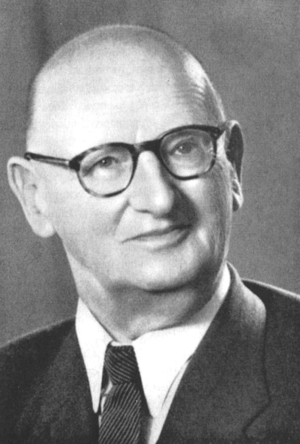
Unternavigation
Arnold Bohren
Arnold Bohren (1875-1957) was director of the Swiss Institute for Accident Insurance (Suva) in the 1930s and 1940s and an influential expert on social insurance.
Bohren grew up in modest circumstances with his family in the Bernese Oberland. After training as a teacher, Bohren studied mathematics and physics at the universities of Bern, Zurich and Paris. Once he completed his studies, he was a lecturer at the Teachers' Seminar in Bern while pursuing a career in academia and politics. In 1905, he was one of the founding members of the Association of Swiss Actuarial Mathematicians. In 1908, he obtained a post-doctoral qualification (Habilitation) at the University of Bern in the field of actuarial mathematics, and was close to Christian Moser. At the same time, he was elected to the municipal council for the city of Bern, representing the Social Democratic Party.
In 1918, Bohren assumed a position as sub-director in the newly founded Swiss Institute for Accident Insurance (Suva). He continued to teach at the Institute for mathematical and actuarial sciences at the University of Bern, where he was appointed professor in 1919. Bohren’s career at Suva culminated in 1936 with his appointment as the institute’s director, succeeding the founding director Alfred Tzaut. Bohren presided over Suva in the difficult period following the Great Depression and during the Second World War, when the Institute not only faced high accident rates, but also mistrust among both the working class as well as employers due to its austerity politics and restrained provision of benefits. Bohren was the first of a whole string of social democrats to hold the position of director of Suva. The Institute pursued this staffing policy in an attempt to overcome the crisis of trust between Suva and the working class. During his tenure as Suva director, Bohren committed himself to the promotion of accident prevention – one of Suva’s domains of activity in which the Institute had previously only followed a rather reserved, employer-friendly policy. However, these efforts were undermined by the outbreak of the Second World War, since a majority of the personnel in the accident prevention department was mobilized in the army; Suva had to largely suspend its prevention activities. Bohren retired from his position at Suva in 1942.
After his tenure at Suva, Bohren was a sought-after expert in matters concerning actuarial mathematics and social policy. The Beveridge Plan was published in Great Britain at the end of 1942. The report called for the integration of the fragmented British social security schemes into a standardised and centralised system. The aim was to achieve basic yet comprehensive insurance protection for the whole population. This debate reached Switzerland at the beginning of 1943. The federal councillor in charge of social security, Walther Stampfli – an advocate of the expansion of state old age provision – instructed the Federal Social Insurance Office (BSV) to examine the extent to which the Beveridge Plan could be applied in Switzerland. In turn, the BSV asked Arnold Bohren for his expertise. The Bohren Report was presented in May 1943 and came to a negative conclusion. Bohren rejected a Beveridge-inspired welfare state system for being too statist. This was particularly due to the fact that it would have competed with private socio-political stakeholders important to Switzerland and it would have likewise contradicted the federalist tradition of the Swiss welfare state. The Bohren Report put an end to any plans for comprehensive social welfare reforms in Switzerland as put forward in Great Britain, France and other European countries at the end of the war.
Literatur / Bibliographie / Bibliografia / References: Lengwiler, Martin (2006), Risikopolitik im Sozialstaat. Die schweizerische Unfallversicherung 1870-1970, Köln.
(12/2014)




